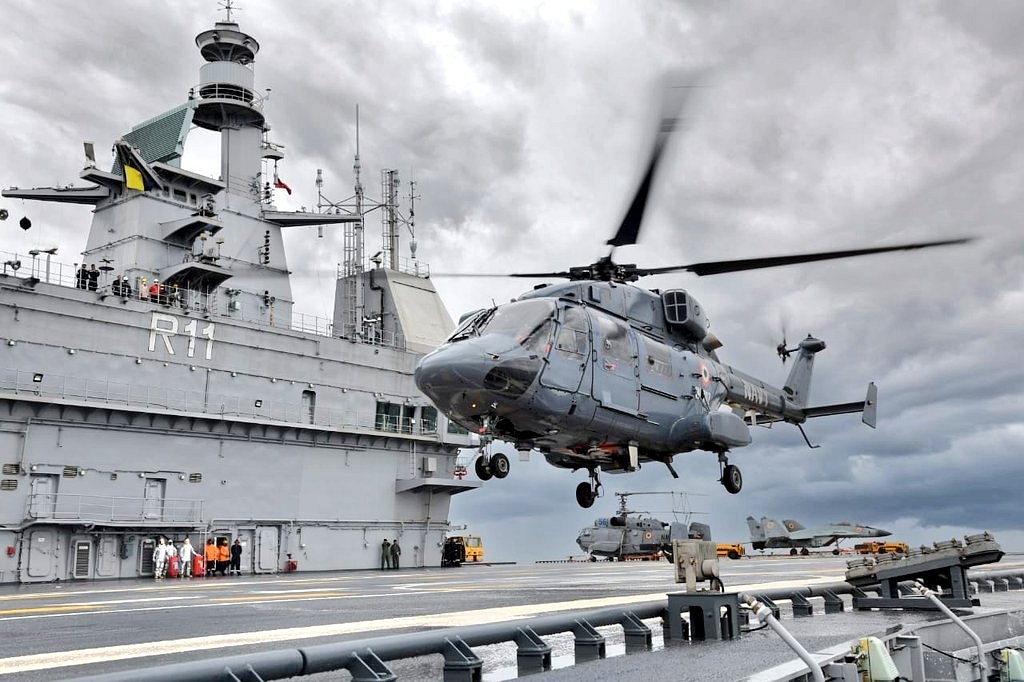Context
As Indigenous Aircraft Carrier Vikrant Completes Last Phase Of Trials, A Look At Its Prospects

Indigenous aircraft carrier Vikrant (Indian Navy/Twitter)
Aircraft carrier Vikrant has completed the fourth and final phase of sea trials. It is scheduled for commissioning into the Indian Navy on 15 August this year.
The significance: This is India's first indigenous aircraft, which puts the country in the elite club of nations.
An aircraft carrier enhances a navy’s capability to travel far from its home shores to carry out air domination operations. It is essential for a navy to be considered a ‘blue water’ navy.
With over 76 per cent indigenous material and equipment on board, 80-85 per cent of the Rs 23,000 crore project cost has been ploughed back into the Indian economy.
Sea trials: Vikrant started its maiden sea trials in August last year. In the five-day trial, propulsion, navigational suite, and basic operations were established. The basin trial was successfully completed in November 2020.
The second sea trial of 10 days was held in October 2021, where the ship was put through its paces in terms of various machinery and flight trials.
The third sea trial, held in January, included ‘complex manoeuvres’.
The fourth trial completed on 10 July had integrated trials of the majority of equipment and systems onboard, including some of the aviation facilities complex equipment.
Aircraft on Vikrant: In the newly released images, the MiG-29K fighter of the Navy, which operates from its only active carrier, INS Vikramaditya, can be seen on Vikrant's deck.
Advanced Light Helicopter (ALH) Dhruv can also be seen operating from the aircraft carrier's deck, with a MiG-29K fighter and a Kamov anti-submarine warfare helicopter in the background.
Unsatisfied with the performance of its MiG-29Ks, the Indian Navy had expressed interest in buying new fighters for its carriers in 2017.
The requirement: With the induction of Vikrant, the Indian Navy will have two aircraft carriers, but not enough fighters to keep both warships operational.
In 2017, the Navy had said it would buy 57 new fighters for its air arm. However, the number has now been cut to 36 because India is developing its own deck-based fighter aircraft.
Boeing's F/A-18 Super Hornet fighter jet and Dassault Aviation's Rafale-M have demonstrated their operational capabilities at the land-based ski-jump facility in Goa, and the Navy is now preparing a detailed report on their performance.
What will be the pick? Experts say Dassault's Rafale-M has an edge over Boeing's F/A-18, as the Indian Air Force has already inducted two squadrons of the fighter, has set up maintenance facilities, and may contract for Rafales in the next few years.
India's rapidly expanding defence partnership with France, which also has a significant presence in the western Indian Ocean, will be considered when New Delhi decides on the procurement of fighters.
The Navy has also aligned its requirements with those of the Indian Air Force, which could see both buying fighters from the same manufacturer to ensure, among other things, economies of scale.
If Rafale-M is selected for procurement, the Indian Navy may ask Dassault to lease it four to five fighters to make aircraft carrier Vikrant operational.
Introducing ElectionsHQ + 50 Ground Reports Project
The 2024 elections might seem easy to guess, but there are some important questions that shouldn't be missed.
Do freebies still sway voters? Do people prioritise infrastructure when voting? How will Punjab vote?
The answers to these questions provide great insights into where we, as a country, are headed in the years to come.
Swarajya is starting a project with an aim to do 50 solid ground stories and a smart commentary service on WhatsApp, a one-of-a-kind. We'd love your support during this election season.
Click below to contribute.
Latest